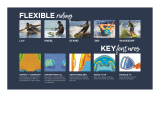
Operation
Always make a pre-start inspection
BEFORE you turn on the ignition.
In an emergency, the snowmobile
engine can be stopped by activating
the engine cut-out switch, pulling
the tether cord cap or turning off the
key.
Throttle mechanism should be
checked for free movement and
return to idle position before start-
ing engine.
Always engage parking brake when
vehicle is not in use.
Never run the engine in a non-
ventilated area and/or if vehicle is
left unattended.
Never operate the engine without
belt guard securely installed or,
with hood or access/side panels
open or removed. Never run the
engine without drive belt installed.
Running an unloaded engine such
as without drive belt or with track
raised, can be dangerous.
Electric start models only: Never
charge or boost a battery while in-
stalled on snowmobile.
Ensure the path behind is clear of
obstacles or bystanders before pro-
ceeding in reverse.
Do not leave your keys in the ig-
nition switch, it is an invitation to
thieves and a danger to young chil-
dren.
Raising the rear of your snowmobile
while the engine is running could
cause snow, ice or debris to be
thrown back at an observer. Nev-
er raise the rear of the vehicle while
the engine is running. To clear or in-
spect the track, stop the engine, tilt
the vehicle on its side and remove
blockage with a piece of wood or
branch. Never allow anyone near a
rotating snowmobile track.
Maintenance
Know your snowmobile and treat
it with the respect and care due of
any power driven machine. Com-
mon sense, proper handling and
routine maintenance will result in
safer and enjoyable use.
Only perform procedures as de-
tailed in this guide. Unless other-
wise specified, engine should be
turned OFF and cold for all lubrica-
tion, adjustment and maintenance
procedures.
Never have the engine running
while the hood is open. Even at
idle, a snowmobile engine is turn-
ing around 1,800 revolutions per
minute. Always turn off the igni-
tion before opening the hood for
any reason.
Never remove any original equip-
ment from your snowmobile. Each
vehicle has many built in safety fea-
tures. Such features include vari-
ous guards and consoles, plus re-
flective materials and warning la-
bels.
A poorly maintained snowmobile
itself can be a potential hazard. Ex-
cessively worn components could
render the vehicle completely in-
operative. Keep the snowmobile
in good working condition at all
times. Follow your pre-operation
check, weekly, monthly and an-
nually routine maintenance and
lubrication procedures as detailed
in this guide. Consult a snowmo-
bile dealer or acquire a shop manual
and proper tools and equipment if
other repairs or service is required.
Do not stud the track unless it as
been approved for studs. At speed,
a studded track that as not been
approved for studs could tear and
separate from vehicle posing a risk
of severe injury or death.
____________
SAFETY INFORMATION
___________
11




















